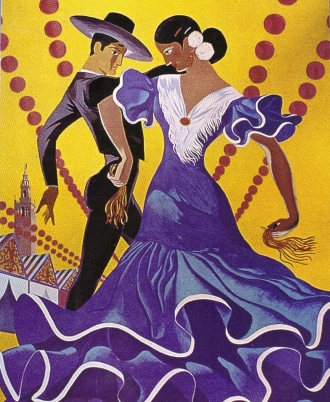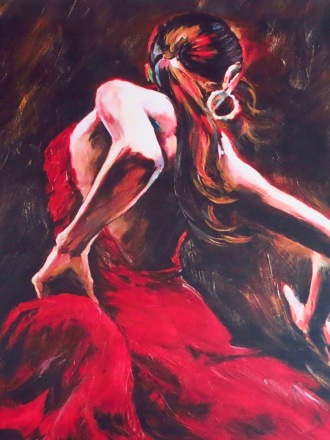“We are in the Spanish south. The castanets click from coast to coast, the cicada hum through the night, the air is heavy with jasmine and orange blossom… the girls have black eyes and undulating carriages.” – Jan Morris, ‘Spain’
We were staying at the Hotel Retiro del Maestre, a renovated old Spanish nobleman’s house on a dusty street leading to the main square of Almagro. It was a friendly family run hotel with spacious and comfortable public rooms, a large outside terrace basking in the pleasant sun and was a nice room for us with a view over the garden.
It was late afternoon by this time and with the sun beginning to dip we didn’t linger long but made our way quickly to the Plaza Mayor to find a bar. On the way we passed by the equestrian statue of the Conquistador Diego de Almagro and then entered the rectangular Plaza.
At a hundred metres long and forty metres wide it is flanked on both sides by arcades of cream Tuscan columns, weathered by the years, supporting overhead galleries all painted a uniform shade of botella verde and fully glazed in a central European style that makes this place truly unique in all of Spain. These galleries were originally open and used as grandstands for public events, religious festivals and even bullfights that were held here until 1785, when they were finally banned by King Carlos III.
We choose a table on the sunny side of the Plaza, ordered beer and wine and just sat and watched the activity while we nibbled the inevitable olives. The bar owner shooed away some small boys playing football, telling them to play elsewhere as families began to arrive and the bar quickly filled up with chattering customers enjoying the late afternoon sunshine.
The Plaza Mayor is the most important part of a Spanish town or city and I really cannot think of an equivalent in the United Kingdom where we have public squares but use them in an entirely different way. This is the place where people meet, relax and enjoy themselves; it is generally flanked with shops and restaurants and usually has the town hall and the main church somewhere close by. In the centre sits a military veteran with only one arm selling Spanish lottery tickets.
When we arrive somewhere new it is usually the first place we make for because sitting with a glass of wine and a complimentary tapas it is the best place to be to get a feeling for the character of the town and its people.
In the search for real Spain we have visited and enjoyed dozens of Plaza Mayors; Madrid, the largest, Salamanca, the second largest, Toledo, next to its towering cathedral and the tiled Plaza de España in Seville. We liked them all and we began now to compile a list with a view to choosing our top five favourites.
We considered Ávila, Mérida and Valladolid, Cáceres and Santiago de Compostella in Galicia but after a lively debate weighing up the pros and cons and putting forward the case for each one in turn we finally agreed on the top five but could not reach absolute consensus on the actual order.
So this is our list: Segovia in Castilla y Leon because of the Cathedral and the architecture and the little streets running away from it like spokes from a wheel, Trujillo, where we had been only today, because of its unspoilt medieval charm, the unpretentious and functional Ciudad Rodrigo, Chinchón with its open balconies and bullfights and although we had only just arrived we liked this place so much that we both agreed to include Almagro in the list.
After a second leisurely drink we paid up and left the square and strolled back to our hotel where we asked for some dining recommendations and the receptionist convinced us to go to her favourite restaurant just a couple of streets away so after we had rested and changed we took her advice and found the place in a side street off the main square.
Although it wasn’t especially late when we finished the meal we were tired after a long day that had started three hundred kilometres away in Mérida, taken us to Trujillo and then a three hour drive to Almagro and we were ready for bed. We walked back through the Plaza Mayor that was lively in a subdued sort of way (if that makes sense) and then to the street to the hotel.
About half way along the route back to the hotel we heard the lyrical sound of Spanish guitars, clacking castanets, the rhythmic stamping of Cuban heels and clicking stilettos, rather like the sound of an approaching steam train and we wondered where it was coming from and then through the pavement level window of a cellar we could see a dancing class in full swing.
Some local people suggested that it would be quite all right to go inside and watch so we did just that and before the lesson ended we enjoyed fifteen minutes of genuine Spanish music played by an assembly of musicians and a group of young people dancing the flamenco; stamping, posturing and pouting in a rapid, aggressive, staccato style – wonderful vivacious movement, flicking to the left and prancing to the right and accompanied all the time by the sound of chattering music like a machine gun firing into the sky.
It was a wonderful way to end the evening!










All I would need is a table in the shade, something cold in my hand and music. Love Spanish music. So much to see. Oh my. Sounds heavenly.
LikeLike
The Plaza Mayor in any town is a wonderful place to be!
LikeLike
I loved studying Spanish at uni in late sixties here Down Under – participation in flamenco dance lessons was a part of the course, which was really thrilling – such beauty and strength there even if my body moves were a disaster from the beginning as far as the dance is concerned 🙂 Love it and always have such style, discipline, elegance…
LikeLike
Spanish is such a wonderful language. I was obliged to learn French and didn’t like it at all, I am sure if I had had the opportunity to learn Spanish then I would have made a better job of language lessons.
Can you still perform a Flamenco?
LikeLiked by 1 person
Mainly with arms these days, Andrew 😀 although feet move too – I think when one’s young it’s easy to empty the mind and dedicate it loosen it a bit to enter the mood needed to “surrender” to the dance music…I still enjoy it and go to Spanish restaurants and clubs to watch the dancing 🙂
LikeLiked by 1 person
Sounds great!
LikeLike
It surely was Sue, thanks for dropping by.
LikeLiked by 1 person
I like the blue and white porcelain notice. I suspect it took a lot more skill to make it than you might think!
LikeLike
I have thought about that myself and have wondered if it is difficult to get the letters to remain lined up through the firing process.
LikeLike
When I think that Australia was settled in the late 1770’s and all these places were built before then; what a wonder.
LikeLike
Yes, it puts things into perspective sure enough!
LikeLike
You make me want to live there!
LikeLike
We could end up as neighbours!
LikeLiked by 1 person
Sounds idyllic, Andrew. My mother could play the castanets, although I have no idea who taught her.
LikeLike
My mum had some which were displayed on a shelf in the living room, she couldn’t play them except in a sort of knocking two halves of a coconut shell together sort of way!
LikeLiked by 1 person
Where to on your next Spanish trip, Andrew? 🙂
LikeLike
Malaga, Ronda and Granada Jo. A first visit to the Alhambra Palace!
LikeLike
A first??? Incredible! Slip Cordoba in there too if you can. 🙂
LikeLiked by 2 people
I have been to Cordoba but it rained that day so I might schedule in a return visit if the weather is kind!
LikeLiked by 2 people
Pingback: Travels in Spain – Off the Beaten Track (1) | Have Bag, Will Travel
Pingback: People Pictures – Blinded By The Light | Have Bag, Will Travel
You’ve been everywhere, man – especially in Spain
LikeLike
I am doing my best Derrick.
LikeLiked by 1 person
You must be Spain’s most well-travelled Englishman Andrew. Is there anywhere left to be discovered?
LikeLike
I have been to all of the regions of Spain except Navarre so I need to put that right.
LikeLiked by 1 person
What about the Balearics?
LikeLike
Never been to Majorca but have been to Menorca and Ibiza.
LikeLiked by 1 person
Should keep you going for a few more trips then.
LikeLiked by 1 person
Despite your being well travelled, Jo’s right. Córdoba’s a must see. It may be our favourite Spanish city.
LikeLike
The dancing sounds neat, Andrew and a great way to end your evening. But I am also a fan of sitting in the Plaza, sipping a cold beer, and watching the world pass by. –Curt
LikeLike